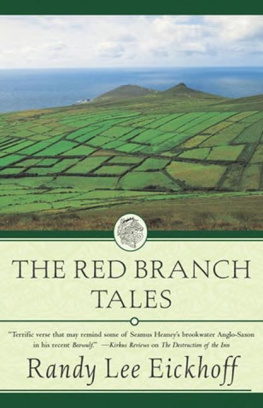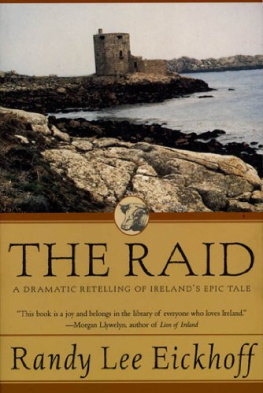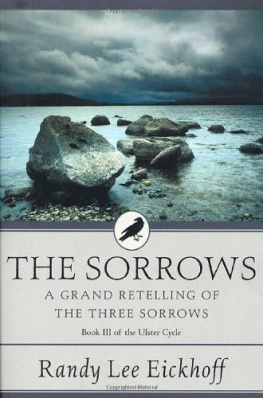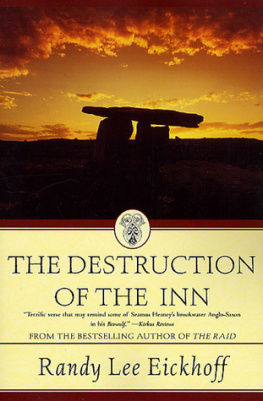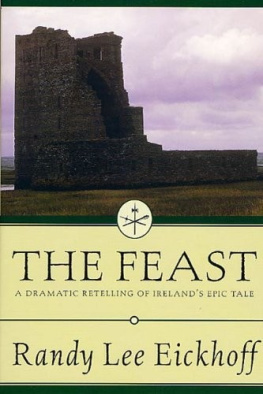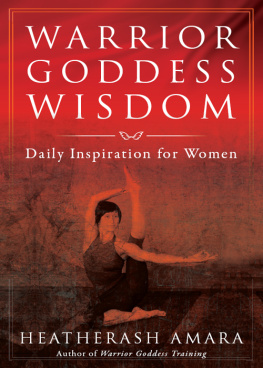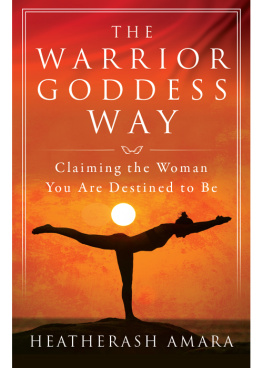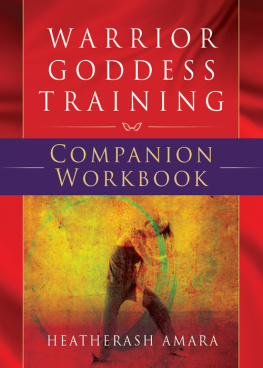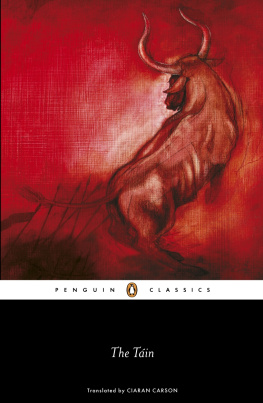The author and publisher have provided this e-book to you without Digital Rights Management software (DRM) applied so that you can enjoy reading it on your personal devices. This e-book is for your personal use only. You may not print or post this e-book, or make this e-book publicly available in any way. You may not copy, reproduce or upload this e-book, other than to read it on one of your personal devices.
Copyright infringement is against the law. If you believe the copy of this e-book you are reading infringes on the authors copyright, please notify the publisher at: us.macmillanusa.com/piracy .
It would be difficult indeed to find a hero, legendary or otherwise, who has had as much impact on a culture as Cchulainn in the Irish Ulster Cycle. Such was the enigmatic and charismatic appeal of the boy-warrior that his image and the heroic ideals he embodied were adopted by those fighting for Irelands independence in 1916, when they realized that, like Cchulainn, they stood alone against the formidable English army in a battle for independence. Sinn Fin, Ourselves Alone, reflects that indefatigable spirit of the Irish who began the Republics struggle toward freedom at the National Post Office in Dublin. The English brought in guns to destroy the post office and dislodge the rebels, necessitating the later rebuilding of the post office by the Irish. After they had finished, they placed one statue in the post office to commemorate the stand of the martyrs: a statue of Cchulainn, who tied himself to a standing stone before he died so he could meet his enemies while still on his feet and alone, defiant against all odds. Such resoluteness makes the skin chill andpebble, as do the stories of this brave youth whose spirit is eternally bonded with the land and its people.
The stories of Cchulainn have, unfortunately, undergone several distortions from the bardic tradition in which they existed for a thousand years or better before they were written down. The basic texts exist in Leabhar [ Lebor ] Na hUidre (the twelfth-century Book of the Dun Cow ) and Leabhar [ Lebor ] Laigneach (the twelfth-century Book of Leinster , also known as Lebar Na Nachongbla ). I have no doubt that during the transcription process the text was substantially altered in accordance with the scribes pleasure and expectations. I base this conviction on a comparison of the tales themselves and on the information available about the culture of the Ancient Irish and speculations about their lifestyle and beliefs. The Anglo-Saxon epic Beowulf was altered by its monastic scribe in the much same way.
The stories of Cchulainn compose the largest part of the Ulster, or Red Branch, Cycle, a group of sagas and romantic tales associated with traditional heroes who roamed the area that is now eastern Ulster, especially the present counties of Louth and Down. Emain Macha, the chief stronghold of the Ulaid, was destroyed around A.D. 332 and has been archaeologically identified as the grassy mound, close to Armagh, that is called Navan Fort (Centre).
This was the site where the powerful king Conchobor ruled, surrounding himself with a group of warrior-knights whose exploits suggest a literary kinship with some of the tales of the Arthurian knights of the Round Table. The exigence of the Red Branch tales, however, suggests that they preceded the Arthurian tales by quite a length of time.
In the Red Branch sagas, Ulster stands alone from the rest of Ireland, proud and haughty, stronger by far than the others thanks to her heroes Cchulainn, Fergus Mac Roich, Loegaire Buadabach the Triumphant, Bricriu of the Poisoned Tongue, Conall Cernach, Sencha Mac Ailill, and Cathbad the Druidamong others. Ulsters hereditary enemy, however, is Connacht, ruled by Ailill and his Amazonian wife, Maeve. Although queens were unknown to the Ancient Irish, many husbands bestowed upon their wives the same powers held by them. Consequently, Maeve is often referred to as Queen Maeve to distinguish the higher regard in which she was held by many (including herself). Maeve and Ailill, like Conchobor, are surrounded by a court of distinguished warriors at Rath Cruachan, their ancient capital.
These stories, whose earliest extant manuscripts date from the twelfth century to the fifteenth, are reflections of a much earlier period in Irish history; some were transcribed from originals written as early as the eighth century. The culture, however, was fairly similar to what prevailed in Ireland before the Christian intercession. The population was not united under one central government but existed instead in tribal unities or groups, each controlling its own district or province, known as ciced (fifth), with Ulster occupying the north at Emain Macha and Connacht the west at Cruachan near the Shannon. The southeast of Ireland was controlled by the Laigin (Leinstermen), who were subdivided into the North and South, and in the southwest was Munster. Meath was carved out of the center after the provinces were united by the Ard R, or High Kings, in the second century after Christ. The famous Tara, symbol of the High King, was, however, unknown as the center of government until several centuries later.
Each ciced was composed of smaller tuathas, or tribes, which were subdivided into even smaller groups, all bound together by fostering, the raising of anothers child, a common practice that united two or more families as provided by the Brehon Laws, which were very explicit about how people and government must comport themselves. All owed allegiance to the R Cicid , or provincial king.
The tales of this strange land, pagan and barbaric but replete with a splendor of civilization, are pastoral, although they lackthe lyrical attention given to pastoral reflections by the later Romantics. Wealth was reflected in cattle and swine that roamed wide moors and deep forests. Exchanges and barters were made with the cow as the basic unit of value. Even slaves were given value in terms of cows (as seen in the Brehon Laws). It is highly significant that the national epic of Ireland is Tin B Cuailng or Cattle Raid of Cooley (translated by the author as The Raid ), which has as its central theme the attempt of the Connachtmen to carry away a famous bull that belonged to an Ulster chieftain.
These tales survived thanks to the poets who sang stories about the heroes and their accomplishments and wove those stories into a bardic tradition which demanded that practitioners be formally trained in the memorizing of certain tales and stories. That the poet was a most valued member of the kings household is reflected by the Brehon Laws, which set his pay as twenty-one cows annually, plus enough pasture lands to feed them, plus two hounds and two horses.
The poetry of the Ancient Irish was highly complex and reflects a feeling and respect for nature. In essence, Ancient Irish poetry was based roughly on sound. That is, I admit, true of all poetry, but an oral tradition requires mnemonic devices such as alliteration, rhythm, and in some cases rhyme. Unfortunately, much of the documentation for the early poetic forms has been distorted by translators and transcribers, but the categories for this poetry are outlined in Appendix A.
The literature of the Ulster Cycle is, however, not exclusively poetry. Most of it is a mixture of poetry and prose, suggesting that the bard may have used a narrative to frame the poetry he believed most important. Curiously enough, the narratives now constitute the main body of early Celtic tradition. It is here, however, that the difficulty lies for the translator, who must not only translate but interpret that translation for his modern audience. A direct translation from Ancient Irish to modern English is, practically speaking, impossible. But the intent of the tale andteller may be given. An example of a Cchulainn tale with as direct a translation as possible is given in Appendix B, but in this collection I have chosen to use the interpretive method instead. This method is, however, nothing new. It appears that, given the structural arrangement of the Ulster Cycle, the works were originally composed to be outlines of the tales, which the poets or bards would be required to flesh out in their telling. This method would offer the illusion of spontaneity as well as provide a means by which the individual could demonstrate his skills. I hasten to add, however, that not all scholars have accepted this theory.


